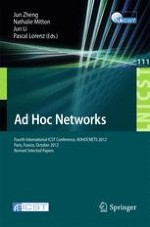This book constitutes the thoroughly refereed proceedings of the fourth International Conference on Ad Hoc Networks, ADHOCNETS 2012, held in Paris, France, in October 2012. The 18 revised full papers presented were carefully selected and reviewed from 43 submissions. These – and 6 invited papers now cover and even broader scope, referring to many types of autonomous wireless networks designed and deployed for a specific task or function, such as wireless sensor networks, vehicular networks, and home networks. They are organized in topical sections on MAC and PHY layers, localization and position-based protocols in WSNs, resource allocations and cognitive radio, key, service and caching management, network architectures and frameworks, and mobility and disconnection management.
